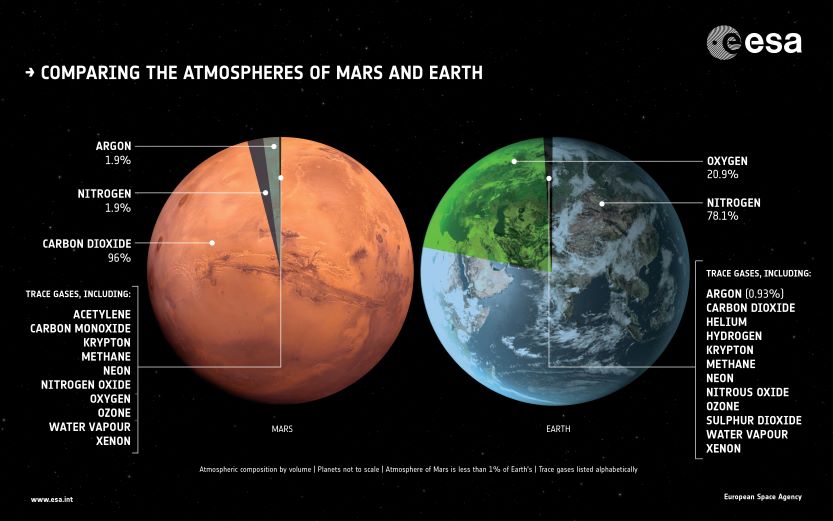Scientist claims life on Earth might have been imported from Mars
About 2–2.5 billion years ago, life in the Solar System made a major shift from one planet onto another. Mars, on one hand, lost its atmosphere and its surface reservoirs of liquid water, and Earth – around the same time – experienced an abrupt increase of oxygen level, an American scientist cited two independent studies.
The Great Oxidation Event, which enabled aerobic metabolism and the complex lifeforms that ultimately led to our existence, was triggered by cyanobacteria, which had been “imported” from nowhere but Mars, according to Avi Loeb, one of the few astrophysicists who believe extraterrestrial life exists beyond our planet.

The researcher claims there’s no coincidence in timing between the two events occur by chance and they are linked by the cause and effect phenomenon.
“If Mars lost its atmosphere as a result of a giant asteroid impact, the same collision could have transferred numerous Martian rocks with biological organisms or unique chemicals to Earth, tilting the balance in favor of cyanobacteria and triggering a transformation of terrestrial life,” Loeb said in an opinion article on Medium.
“The possibility that Mars and Earth share the same biological ancestry will be testable as soon as we identify traces of life from Early Mars,” he said, adding that “the ancestry could go deeper and involve intelligence.”
He calculated in a previous essay that if an advanced technological civilization originated on Mars twice as fast as on Earth and then disappeared when Mars lost its habitability, then all technological infrastructure on Mars would have been eroded into dust by now as a result of asteroid impacts.
More to read:
Humans won’t put their feet on Mars any time soon – kidneys are the problem
This natural devastation would have been equivalent to dropping several tens of Hiroshima atomic bombs per square kilometer on the Martian surface.
If an advanced technological civilization existed on early Mars, he continued, surely there would have been a Martian version of Elon Musk who had founded a Martian company with the goal of bringing Martians to Earth after expressing a wish to die on Earth. Inhabiting Earth became their obvious path to salvation, and terraforming Earth became a major priority in Martian politics.
“And imagine that this wish was fulfilled 2–2.5 billion years ago, unlike the mirror-image of Musk’s current wish to die on Mars which is yet to be carried out,” the scientist speculated.
More to read:
Exoplanet K2-18b may harbor life
But was the Great Oxidation Event the result of a Martian project for terraforming Earth? Maybe, says Loeb.
“The rise in cyanobacteria activity could have been artificially cultivated by suppressing competing species, by seeding or by enhancing the nutrients that allowed cyanobacteria to thrive,” his thinking goes on.
Although he admits this theory looks like science fiction but stressed that his “Terraformed Earth” hypothesis is testable based on the scientific method. It could easily ruled out by studying early life on Earth or Mars and finding that the genetic code of living organisms on the two planets are different.
Search for archaeological evidence could also be extended beyond Earth and Mars - the Moon too is a candidate for signs of presence of an earlier civilization, suggests Avi Loeb, whose Galileo Project just happens to be involved in such operations.
More to read:
The Milky Way contains trillions of orphan planets
Analyses of data that helped date Martian salt craters thanks to the Mars Reconnaissance Orbiter imply that Mars had liquid water about 2–2.5 billion years ago. Another NASA mission, MAVEN Orbiter, presented evidence that Mars lost its atmosphere around that time.
However, the Perseverance Rover that roams the red planet has not noticed any relics of Martian technology. Nor have we found any here on Earth.
According to Loeb, the technological infrastructure of a civilization that predated Earth’s life forms and then perished billions of years ago, would have been removed by meteor impacts and geological activity such as volcanoes and plate tectonics.
All we have to do is find the places where the devastation was incomplete, he noted.

The scientist [pictured above] gained fame among the general public thanks to his affirmation that the interstellar space rock Oumuamua, which crossed the Solar System in 2017, was actually an extraterrestrial probe on a mission to collect information about it.
Avi Loeb is the head of the Galileo Project, founding director of Harvard University’s Black Hole Initiative, director of the Institute for Theory and Computation at the Harvard-Smithsonian Center for Astrophysics, and chair of the advisory board for the Breakthrough Starshot Project.
Formerly, he chaired the astronomy department at Harvard University, the Board on Physics and Astronomy of the National Academies, and served in the President’s Council of Advisors on Science and Technology.
***
NewsCafe is an independent outlet that cares about big issues. Our sources of income amount to ads and donations from readers. You can support us via PayPal: office[at]rudeana.com or paypal.me/newscafeeu. We promise to reward this gesture with more captivating and important topics.







